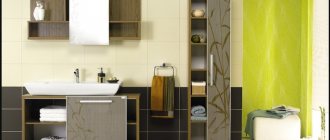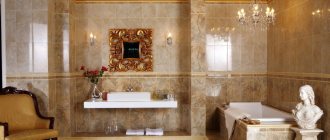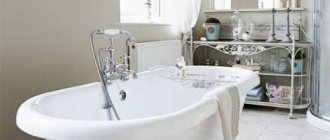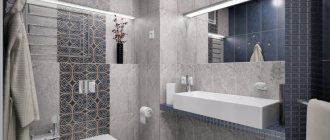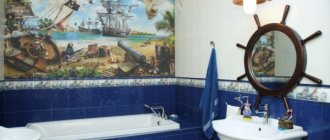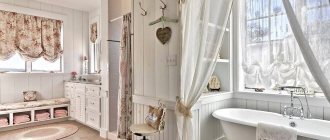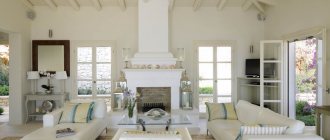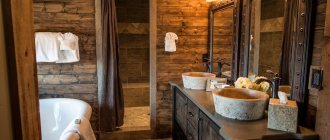Despite the fact that art deco has existed for more than 100 years, it is incredibly popular today and is quite often found not only in living rooms, bedrooms, but also in bathrooms. This style is devoid of even a shadow of minimalism, simplicity, free spaces, and asceticism. This is a style of luxury, a “song” to stormy, vibrant art with a touch of unrestrained theatricality. Everything in it is built according to the laws of the classics, but there is no trace of decrepit antiquity. An Art Deco bathroom, like any other room, will have Roman, Japanese, Greek, Chinese motifs and look like the room of an ardent art collector of various styles. In art deco, a lot is inspired by cubism, correct geometry connecting planes so that the result is not just decor, but an object of art. It’s not for nothing that the word “art” is in the title.
Despite the fact that art deco has existed for more than 100 years, it is incredibly popular today and is quite often found not only in living rooms, bedrooms, but also in bathrooms
Contrast
Color solutions in Art Deco design must be based on the use of contrast between two colors. The most common contrasting color pair is basic black and white. However, close to them are often used - dark gray, gray, beige, ivory. Shades from other spectrums of the color wheel, such as purple, pink and gold, are also used, but much less frequently.
The idea of contrasting basic colors should be supported not only by the decoration of walls, floors and ceilings, but also by the filling of the bathroom: plumbing fixtures, chandeliers, furniture, decorative elements. Additional colors that do not serve as primary (contrasting) colors should be muted and inconspicuous.
Photo:
The meaning of art deco materials
To decorate walls, as a rule, wallpaper is used that does not have any pattern or design. All walls are painted the same tone. Splendor is created through the use of a stencil border with possible geometric shapes. Thus, in the 30s, the symbol of the rising sun was especially popular.
The classic option for wall decoration is white and black ceramic tiles. In some cases, several shades of tiles are combined or decorated with tiles, where there are ornaments in the form of various figures. The uniqueness of the design when decorating walls is given by the use of a dividing strip, rich in ethnic patterns.
Leopard print and designs imitating snake skin are in demand in this area. Ceramics can embody the beauty and grace of such textures. Relief tiles with abstract elements are perfect for the bathroom interior.
It is important to decorate walls imitating marble. You can also choose tiles with a similar pattern. An unpredictable mosaic will become a striking element of the interior.
The walls are also decorated with stucco or painting.
As for the floor, it is decorated using large marble slabs. Here, the laying technique is of great importance, which involves the implementation of a complex geometric pattern. A modern solution would be the chess method.
For finishing work it is permissible to use plastic substitutes.
Geometry
Squares and rhombuses, ovals and circles, angles, symmetry, planes, straight and broken lines - all this is found not only in geometry. This is also one of the foundations of Art Deco - the more geometry in the interior, the better. These motifs can be transferred to bathroom design. Most of the shapes of the style are regular geometric shapes, the use of which can be found not only in plumbing, but also in the design on the floor, in the shape of bedside tables and cabinets, in the shape of mirrors and chandeliers, in pronounced zoning planes.
Photo:
How important is color?
Correct selection of colors is one of the most important stages of interior planning.
In Art Deco, playing with shades is used for the following purposes:
- creating the necessary associations: monochrome, gold, silver, dark brown shades are widely used, suggestive of luxury and wealth;
- placement of accents: art deco is based on the fusion of two opposing styles - modernity and neoclassicism, therefore it uses techniques of shading details in opposite tones;
- highlighting contrasts: simple white, cream, pastel colors are combined with luxurious gold, silver, chrome inserts, which creates a fusion effect characteristic of the style;
- creating an atmosphere: using the right colors sets a person up for relaxation and distracts from worries, which is important for competent bathroom design.
The correct use of color will help correct the shortcomings of the room. For example, light colors will expand the room, and small ornaments will hide uneven walls.
Patterns
When decorating a bathroom in the Art Deco style, you can use not only geometric shapes, but also plant and animal patterns. This could be a mosaic or a painting on the wall, a pattern on the floor, elements of the edging of objects. The main thing is that the color schemes of the patterns also support the contrast of the main pair. You can use a living plant or an animal figurine as a small accent spot on a large area of one of the main colors.
Photo:
Finishing
When it comes to Art Deco style, much attention is paid to the decoration itself. Preference, of course, is better to give to expensive and luxurious materials. So, the walls can be lined with natural stone. High quality glossy ceramic tiles are suitable for the floor. Or you can use silk-screened wallpaper.
Very often, the Art Deco direction is recognized by the stone slabs on the floor, which are laid out in the form of an unusual and not entirely clear pattern. The same geometry can be repeated on the main wall. But you don’t need to get too carried away. Overloading with patterns will reduce the volume of the bathroom and create the impression of something superfluous and heavy.
As for the ceiling, tiles are also often used to decorate it. In this case, an original technique is to decorate the perimeter of the ceiling in a frame of a contrasting color. Sometimes the central chandelier and lamp are surrounded by the same frame. But this technique will look good only if the bathroom has a large area.
It is worth noting that the Art Deco style implies the use of wallpaper with different animal elements.
However, in a room where people wash, this is not entirely practical. After all, even the most resistant wallpaper cannot withstand constant contact with water and hot vapors. If the bathtub is small and splashes fly everywhere, then it is, of course, better to choose tiles for framing the walls. But if such a room is spacious, then one wall can be dedicated to wallpaper.
In terms of style, they should have a deep color, on which a large ornament is superimposed. It is ideal if such a pattern is made with gold or silver threads.
The meaning of little things
The style chosen for decoration should be visible in everything, even in the smallest elements of the interior. When choosing a particular item for a bathroom in Art Deco design, you need to clearly understand where it will be located and whether it fits into the existing picture. Think about the proper placement of mirrors and accessories so that the room does not become cluttered and appears visually larger.
Photo:
Mirrors
Any bathroom cannot do without mirrors. If in most bathrooms a mirror is an ordinary object, the presence of which is dictated rather by the purpose of the room, then in the Art Deco style the mirror is one of the main points on which the entire interior is built. It visually increases the space and also serves as another decorative element.
The main mirror of the room should either be large, framed by a wide massive frame, or it should completely occupy the entire wall or a geometrically designated place for it, for example a niche. For an Art Deco style mirror, it is also important to have an individual design that maintains the chic and gloss of the entire room.
If there are additional mirrors in the bathroom, they should be noticeably smaller than the main one and serve rather as a purely decorative element.
Photo: 69.media.tumblr.com
1/2
Photo: designingidea.com
2/2
More light!
It’s hard to imagine Art Deco without the rays of the rising sun. The style may contain decorative items in the form of zigzags, triangles or circles. If you use the materials correctly, you can create an original painting of the sun.
As for lighting fixtures, sophisticated chandeliers can be used here. As a rule, such lamps have a multi-stage shape.
Plumbing and furniture
Despite the style's bias towards geometry, plumbing fixtures and furniture in the bathroom can be of any shape. It is better if these are massive objects with smooth lines that support the main color pair. Along with the dimensions, it is also important that the plumbing is modern and high-tech. But we must not forget about its finishing. The base of the bathtub, facades and tabletops of furniture, supports are a huge field for the use of expensive materials and individual design solutions.
Photo:
Accessories
Few but impressive accessories set off the style well.
- A fountain or its imitation is an exclusive and striking detail of a bathroom interior
- A small abstract sculpture looks impressive in such a bathroom
- A bright photograph of a skyscraper will refresh the decor.
Note!
Toothbrushes, combs, creams do not need to be kept in sight; only two or three shiny crystal bottles can stand on an open shelf.
Lighting
For lighting in bathrooms in Art Deco design, “classic” lamps are often used. A large pendant chandelier with many pendants and decorative ornaments or a geometric chandelier (sphere, square) is usually chosen as the main light source. Usually the main chandelier is made of expensive materials.
For additional lighting of individual areas, lamps that match the style are used, but there should be a minimum number of them.
Photo: i0.wp.com
1/2
Photo: wallmirrors.eu
2/2
Accents
If the size of the room allows, then to accentuate the style in the bathroom you can place an unusual item for it. This could be a chair, an ottoman, or a living plant. It is important to remember that if this is a piece of furniture, then it should be elegant, made of expensive materials. If a chair or ottoman can stand out in the surrounding environment and be a bright accent spot, then the decorative plant should be selected very carefully. On the one hand, it should not contrast strongly with the general background of the place where it will be installed, on the other hand, it should also attract attention.
Photo: trend4homy.com
1/2
Photo: nouvellesideesdecoration.com
2/2
Shine
Gloss is something that must be present in our style. If this is not the case, the bathroom is designed in an incomprehensible way.
For example, a shiny floor will look impressive in a bathroom. Gloss may also be present in furniture. Even on the doors you can make some inserts that can be made of glass. And all this will be decorated with lamps.
However, such a dominance of shiny elements should not strain the eye, nor create excessive pomp. You can balance the glossy effect by using matte surfaces.
